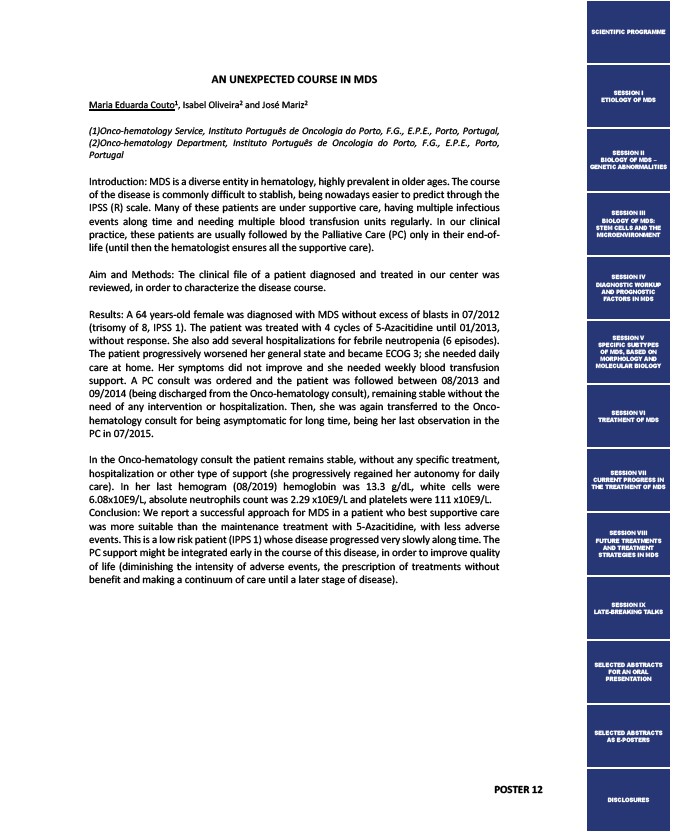
AN UNEXPECTED COURSE IN MDS
Maria Eduarda Couto1, Isabel Oliveira2 and José Mariz2
(1)Onco-hematology Service, Instituto Português de Oncologia do Porto, F.G., E.P.E., Porto, Portugal,
(2)Onco-hematology Department, Instituto Português de Oncologia do Porto, F.G., E.P.E., Porto,
Portugal
I
ntroduction: MDS is a diverse entity in hematology, highly prevalent in older ages. The course
of the disease is commonly difficult to stablish, being nowadays easier to predict through the
IPSS (R) scale. Many of these patients are under supportive care, having multiple infectious
events along time and needing multiple blood transfusion units regularly. In our clinical
practice, these patients are usually followed by the Palliative Care (PC) only in their end-of-life
(until then the hematologist ensures all the supportive care).
Aim and Methods: The clinical file of a patient diagnosed and treated in our center was
reviewed, in order to characterize the disease course.
Results: A 64 years-old female was diagnosed with MDS without excess of blasts in 07/2012
(trisomy of 8, IPSS 1). The patient was treated with 4 cycles of 5-Azacitidine until 01/2013,
without response. She also add several hospitalizations for febrile neutropenia (6 episodes).
The patient progressively worsened her general state and became ECOG 3; she needed daily
care at home. Her symptoms did not improve and she needed weekly blood transfusion
support. A PC consult was ordered and the patient was followed between 08/2013 and
09/2014 (being discharged from the Onco-hematology consult), remaining stable without the
need of any intervention or hospitalization. Then, she was again transferred to the Onco-hematology
consult for being asymptomatic for long time, being her last observation in the
PC in 07/2015.
In the Onco-hematology consult the patient remains stable, without any specific treatment,
hospitalization or other type of support (she progressively regained her autonomy for daily
care). In her last hemogram (08/2019) hemoglobin was 13.3 g/dL, white cells were
6.08x10E9/L, absolute neutrophils count was 2.29 x10E9/L and platelets were 111 x10E9/L.
Conclusion: We report a successful approach for MDS in a patient who best supportive care
was more suitable than the maintenance treatment with 5-Azacitidine, with less adverse
events. This is a low risk patient (IPPS 1) whose disease progressed very slowly along time. The
PC support might be integrated early in the course of this disease, in order to improve quality
of life (diminishing the intensity of adverse events, the prescription of treatments without
benefit and making a continuum of care until a later stage of disease).
POSTER 12
SCIENTIFIC PROGRAMME
SESSION I
ETIOLOGY OF MDS
SESSION II
BIOLOGY OF MDS –
GENETIC ABNORMALITIES
SESSION III
BIOLOGY OF MDS:
STEM CELLS AND THE
MICROENVIRONMENT
SESSION IV
DIAGNOSTIC WORKUP
AND PROGNOSTIC
FACTORS IN MDS
SESSION V
SPECIFIC SUBTYPES
OF MDS, BASED ON
MORPHOLOGY AND
MOLECULAR BIOLOGY
SESSION VI
TREATMENT OF MDS
SESSION VII
CURRENT PROGRESS IN
THE TREATMENT OF MDS
SESSION VIII
FUTURE TREATMENTS
AND TREATMENT
STRATEGIES IN MDS
SESSION IX
LATE-BREAKING TALKS
SELECTED ABSTRACTS
FOR AN ORAL
PRESENTATION
SELECTED ABSTRACTS
AS E-POSTERS
DISCLOSURES